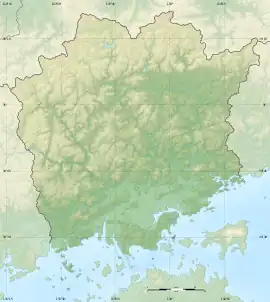| Katsuyama Domain 勝山藩 | |
|---|---|
| under Tokugawa shogunate Japan | |
| 1767–1871 | |
 Mon of the Miura clan
| |
| Capital | Katsuyama Castle |
| Area | |
| • Coordinates | 35°5′22.92″N 133°41′35.25″E / 35.0897000°N 133.6931250°E |
| • Type | Daimyō |
| Historical era | Edo period |
• Established | 1767 |
• Disestablished | 1871 |
| Today part of | part of Okayama Prefecture |




Katsuyama Domain (勝山藩, Katuyama-han) was a feudal domain under the Tokugawa shogunate of Edo period Japan, located in Mimasaka Province in what is now the northern portion of modern-day Okayama Prefecture. It was centered around Katsuyama Castle which was located in what is now the city of Maniwa, Okayama and was controlled by a cadet branch tozama daimyō Miura clan throughout all of its history. [1][2][3] It was initially known as Takada Domain (高田藩) after the original name of Katsuyama Castle, and in the late Bakumatsu period it was renamed Mashima Domain (真島藩) after its location in Mashima County.
History
In 1764, the fudai daimyō Miura Akitsugu transferred from Nishio Domain in Mikawa Province to a holding of equivalent kokudaka in Mimasaka Province. He rebuilt Takada Castle and renamed it Katsuyama Castle, and laid out a new jōkamachi which became the Katsuyama neighborhood of Maniwa. His son, Miura Noritsugu, encouraged the development of iron mines and iron ore remained a domain monopoly to the end of the Edo Period. The 9th daimyō, Miura Hirotsugu, supported the shogunate in the Bakumatsu period, but his son, and final daimyō, Miura Takatsugu supported the imperial cause and the clan was later ennobled with the kazoku peerage title of shishaku (viscount).
In 1871 domain became "Mashima Prefecture" due to the abolition of the han system. It was incorporated into Okayama Prefecture via Hojo Prefecture.
Holdings at the end of the Edo period
As with most domains in the han system, Katsuyama Domain consisted of several discontinuous territories calculated to provide the assigned kokudaka, based on periodic cadastral surveys and projected agricultural yields.[4][5]
- Mimasaka Province
- 107 villages in Mashima District
- 1 village in Ōba District
List of daimyō
# Name Tenure Courtesy title Court Rank kokudaka  Miura clan, 1764-1871 (fudai daimyō)
Miura clan, 1764-1871 (fudai daimyō)1 Miura Akitsugu (三浦 明次) 1764 - 1772 Shima-no-kami (志摩守) Junior 5th Rank, Lower Grade (従五位下) 23,000 koku 2 Miura Noritsugu (三浦 矩次) 1772 - 1780 Shima-no-kami (志摩守) Junior 5th Rank, Lower Grade (従五位下) 23,000 koku 3 Miura Chikatsugu (三浦前次) 1780 - 1816 Shima-no-kami (志摩守) Junior 5th Rank, Lower Grade (従五位下) 23,000 koku 4 Miura Terutsugu (三浦毗次) 1816 - 1830 Bingo-no-kami (備後守) Junior 5th Rank, Lower Grade (従五位下) 23,000 koku 5 Miura Nobutsugu (三浦誠次) 1830 - 1831 Shima-no-kami (志摩守) Junior 5th Rank, Lower Grade (従五位下) 23,000 koku 6 Miura Toshitsugu (三浦峻次) 1831 - 1839 Iki-no-kami (壱岐守) Junior 5th Rank, Lower Grade (従五位下) 23,000 koku 7 Miura Yoshitsugu (三浦義次) 1839 - 1848 Bingo-no-kami (備後守) Junior 5th Rank, Lower Grade (従五位下) 23,000 koku 8 Miura Akitsugu (三浦朗次) 1848 - 1860 Shima-no-kami (志摩守) Junior 5th Rank, Lower Grade (従五位下) 23,000 koku 9 Miura Hirotsugu (三浦弘次) 1860 - 1868 Bingo-no-kami (備後守) Junior 5th Rank, Lower Grade (従五位下) 23,000 koku 9 Miura Takatsugu (三浦顕次) 1868 - Bingo-no-kami (備後守)
Genba-no-kami (玄蕃守)Junior 5th Rank, Lower Grade (従五位下) 23,000 koku
See also
Further reading
- Bolitho, Harold. (1974). Treasures Among Men: The Fudai Daimyo in Tokugawa Japan. New Haven: Yale University Press. ISBN 978-0-300-01655-0; OCLC 185685588
References
- ↑ Nakayama, Yoshiaki (2015). 江戸三百藩大全 全藩藩主変遷表付. Kosaido Publishing. ISBN 978-4331802946.(in Japanese)
- ↑ Nigi, Kenichi (2004). 藩と城下町の事典―国別. Tokyodo Printing. ISBN 978-4490106510.
- ↑ Papinot, E (1910). Historical and Geographic Dictionary of Japan. Tuttle (reprint) 1972.
- ↑ Mass, Jeffrey P. and William B. Hauser. (1987). The Bakufu in Japanese History, p. 150.
- ↑ Elison, George and Bardwell L. Smith (1987). Warlords, Artists, & Commoners: Japan in the Sixteenth Century, p. 18.